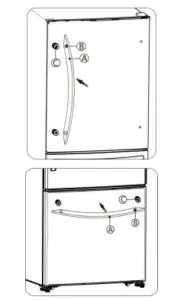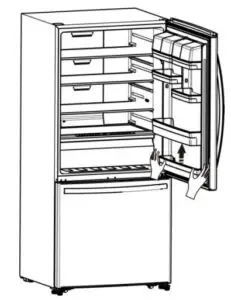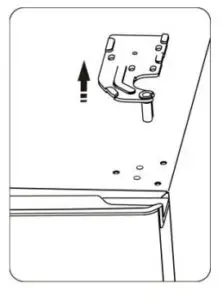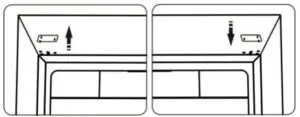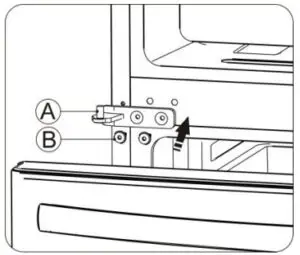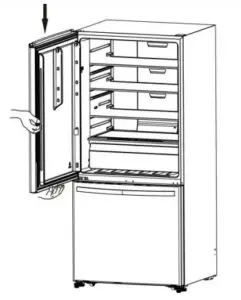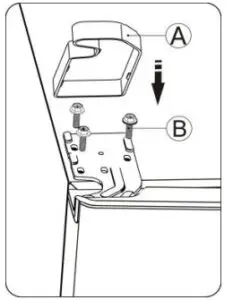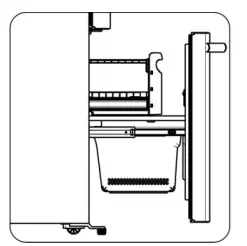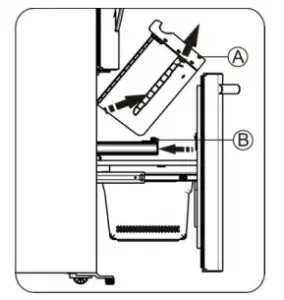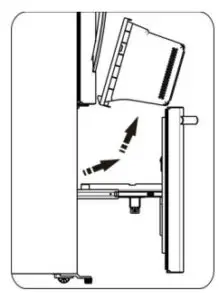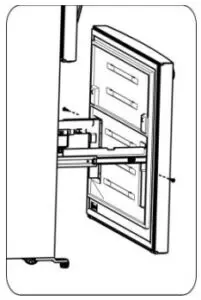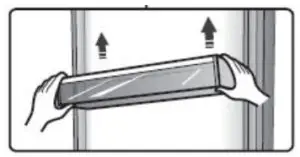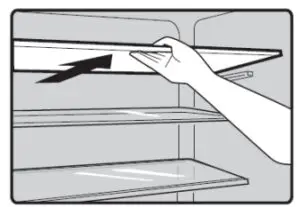Brief Introduction
Thank you for choosing Hisense. We are sure you will find your new refrigerator a pleasure to use. Before you use the appliance, we recommend that you read through these instructions carefully, which provides details about its usage and functions.
- Please ensure that everyone using thisappliance is familiar with its operations and safety features. It is important that you install the appliance correctly and pay careful attention to the safety instructions.
- We recommend that you keep this user’s manual with the appliance for future reference.
- This appliance is intended to be used in households and similar applications such as: -Staff kitchen-areas in shops, offices and other working environments; -Clients in hotels, motels and other residential types of environment; -Bed and breakfast type of environments; -Catering and similar non-retail applications.
- This appliance is not intended for use by persons (including children) with reduced physical, sensory or mental capabilities, or lack of experience and knowledge, unless they have supervision or been given instruction concerning use of the appliance. Children should be supervised to ensure that they do not play with the appliance.
- Do not store explosive substances such as aerosol cans with a flammable propellant in this appliance.
WARNING — Connect to potable water supply only.WARNING — Do not use mechanical devices or other means to accelerate the defrosting process, other than those recommended by the manufacturer.WARNING — Do not damage the refrigerant circuit.WARNING — Do not use electrical appliances inside the food storage compartments of the appliance, unless they are of the type recommended by the manufacturer.WARNING — When disposing of the appliance do so only at an authorized waste disposal centre. Do not expose to flame.WARNING—The instructions include the following wording regarding the use of extension cords or ungrounded (two prong) adapters: Do not use an extension cord or ungrounded (two prong) adapters.WARNING—If the supply cord is damaged, it must be replaced by the manufacturer, its service agent or similarly qualified persons in order to avoid a hazard.
Important Safety Instructions
General safety and daily use
It is important to use your appliance safely. We recommend that you follow the guidelines below.Store any food in accordance with the storage instructions from the manufacturer.
- Don’t try to repair the appliance yourself. It is dangerous to alter the specifications or modify this product in any way. Any damage to the power cord may cause ashort circuit, fire or electric shock.
- Don’t place too much food directly against the air outlet on the rear wall of both the refrigerator and freezer compartment, as it affects sufficient air circulation.
- Don’t place hot items near the plastic components of this appliance.
- Frozen food must not be refrozen once it has been thawed out.
- Don’t store bottled or canned drinks(especially carbonated drinks) in the freezer compartment. Bottles and cans may explode.
- Use caution consuming popsicles or ice cubes straight from the freezer as this can cause freezer burn to the mouth and lips.
Safety for children and infirm persons
- Keep all packaging away from children to avoid risk of suffocation.
- Protect children from being scalded by touching the compressor at the rear bottom of appliance
- Don’t place items on top of the appliance as this could cause injury should they falloff.
- Never allow children to play with the appliance by hanging or standing over or on the doors, racks, shelves and drawers etc.
Electrical Safety
To avoid the risks that are always present when using an electric appliance, we recommend that you pay attention to the instructions about electricity below.
- Unpack and check through the appliance. Should any damage be evident, don’t plug in the appliance but contact the shop immediately from which you purchased it. Keep all packing materials in this case.
- We recommend that you wait for 4 hoursbefore connecting the appliance to allow the refrigerant to flow back into the compressor.
- The appliance must be applied with single phase alternating current of 115V/60Hz If the voltage fluctuates exceeding the upper limit, A.C. automatic voltage regulator of more than 350W should be applied to the refrigerator for safety use.
- The power plug must be accessible when the appliance is installed.
- This appliance must be grounded.
- This appliance is fitted with a plug, in accordance with local standard. The plug should be suitable for use in all houses fitted with sockets in accordance with current specifications.
- If the fitted plug is not suitable for your socket outlets, it should be cut off and carefully disposed of. To avoid a possible shock hazard, do not insert the discarded plug into a socket. If in doubt contact a qualified, registered electrician.
- Do not use extension cords, ungrounded (two prong) adapters or multiple sockets which could cause overloading of wiring circuits and could cause a fire. Always plug your appliance into its own individual electrical socket which has a voltage rating that matched the rating plate.
- Make sure that the plug is not squashed or damaged. Otherwise, it may cause short circuit, electric shock or overheat and even cause a fire.
- Do not insert the power plug if the socket is loose, there is a risk of electric shock or fire.
- Switch off the appliance and disconnect it from the main power before you clean or move it.
- Never unplug the appliance by pulling on the electrical cord. Always grip the plug firmly and pull straight out from the socket to prevent damaging the power cord.
- Do not operate the appliance without the cover of interior lighting.
- Any electrical component must be replaced or repaired by a qualified electrician or authorized service engineer. Only genuine replacement parts should be used.
- Do not use electrical appliances such as ice cream makers inside the food storage compartments of the appliance unless they are approved by the manufacturer.
- To avoid eye injury, do not look direct into the LED light located in the refrigerator compartment. If it is not functioning correctly, consult a qualified, registered electrician or replace it in accordance with the “cleaning and care” chapter.
Refrigerant
The refrigerant isobutene (R600a) is contained within the refrigerant circuit of the appliance. During transportation and installation of the appliance, ensure that none of the components of the refrigerant circuit becomes damaged. The refrigerant (R600a) is flammable.
![]() Caution: Risk of Fire
Caution: Risk of Fire
- Don’t store products which contain flammable propellants (e.g. spray cans) or explosive substances in the appliances.
Should the refrigerant circuit be damaged:
- Avoid open flames (candles, lamps etc.) and sources of ignition.
- Thoroughly ventilate the room in which the appliance is situated.
Installing Your New Appliance
Before using the appliance for the first time, you should be informed of the following tips.Warning!For proper installation, this refrigerator must be placed on a level surface of hard material that is the same height as the rest of the flooring. This surface should be strong enough to support a fully loaded refrigerator.The rollers, which are not castors, should be only used for forward or backward movement. Moving the refrigerator sideways may damage your floor and the rollers.
Ventilation of appliance
In order to improve efficiency of the cooling system and save energy, it is necessary to maintain good ventilation around the appliance for the dissipation of heat. For this reason, sufficient clear space should be available around the refrigerator.Suggestion: It is advisable for there to beat least 75 mm of clearance from the back of the fridge to the wall, at least 100 mm of clearance from its top, at least 100 mm from its side to the wall and a clear space in front to allow the doors to open 140°. As shown in following diagrams.
Note:
- This appliance performs well with ambient temperature between 12.8℃ to 43.3 ℃ . The appliance may not work properly if left at a temperature above or below the indicated range.
- Stand your appliance in a dry place to avoid high moisture.
- Keep the appliance out of direct sunlight, rain or frost. Stand the appliance away from heat sources such as stoves, fires or heaters.
Leveling of appliance
- For sufficient leveling and air circulating in the lower rear section of the appliance, the bottom feet may need to be adjusted. You can adjust them manually by hand or by using a suitable tool.
- To allow the doors to self-close, tilt the top backwards by 10-15mm.
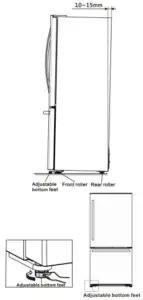
Installing the handles
Before you use the appliance, you have to install the handles provided in the fridge chamber.The longer one is fridge door handle, the shorter one is freezer door handle.Please follow procedures below to install and reverse the handle.
- Place the handle (A) on the door by fitting the handle footprints over the handle supports (C), then fasten the screws (B) with 3mm Allen wrench (provided in plastic).

- When you reverse the fridge door, please move the handle (A), the screws (B) and the handle supports (C) to the right side. Move the screw hole covers (D) to the left side.

Reversing the fridge door
The side at which the door opens can be changed, from the right side (as supplied) to the left side, if the installation site requires.Warning! When reversing the door, the appliance must not be connected to the mains. Ensure that the plug is removedfrom the mains socket..
Tools you will need(Not provided):

Note:When required, tilt the refrigerator back in order to gain access to the base, you should rest the appliance on soft foam packaging or similar material to avoid damaging the backboard of the refrigerator. To reverse the door, the following steps are generally recommended.
- . Stand the refrigerator upright. Open the upper door to take out all door racks (to avoid racks damaged) and then close the door.

- With the door closed, remove the upper hinge cover (A) (you can pry it up with slotted screwdriver) on the top right side of appliance and remove 3 special flange screws (B) with Wrench. Keep the upper hinge cover for future reference.

- Remove the upper hinge (Please hold upper door by hand when installing). Keep it for future reference.

- Use your both hands to open the door more than 90°. Lift it up and take it off.

- Loose screw (B) on the bottom of the fridge door and take down stop block (A), then install stop block (A) to the left side with screw (B).

- Open the freezer door, then loose 2 screws (B) with 4mm Allen Wrench(provided in plastic) and remove middle hinge (A). Keep the middle hinge (A) for future reference.

- Change screw hole covers and screws on middle cover plate from left to right.

- Remove screw hole cover (left) from the top left side of appliance and install it onto the top right side of refrigerator body.

- Put out the left middle hinge (A) (provided in plastic). Then screw it with 2 screws (B) from right side.

- Close the freezer door. Refer to step 4, put the fridge door back on the other side, then close the fridge door and move it to an appropriate position.

- Put out the left upper hinge from plastic bag provided. Then put it on the top left side refer to step 3.

- Put out the upper hinge cover (A) from plastic bag provided, install them refer to step 2.

Freezer Door Removal
In case your home access door is too narrow for the refrigerator to pass through, remove the refrigerator doors and drawers as follows.
- Pull out the freezer door and the upper freezer drawer to the final position.

- Take out the upper freezer drawer (A) by lifting it up from the rail system (B). Then push the rail system (B) back.

- Remove the lower freezer drawer by lifting it up.

- Remove the 2 screws attached to the supporting frame.

- Pull out the freezer door and lift it up in the direction of the arrow.

Re-assembling the freezer door
To reattach the drawer after you moved the appliance to its final location, assemble the parts in reverse order.
Description of the Appliance
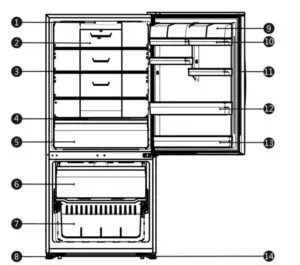
Note!:
- Due to unceasing modification of our products, your refrigerator may be slightly different from this instruction manual, but its functions and using methods remain the same.
- To get the best energy efficiency of this product, please place all shelves, drawers and baskets on their original position as the illustration above.
Display Controls:
Use your appliance according to the following control regulations, your appliance has the corresponding functions as the control panels showed in the pictures below.
Controlling the temperature:
We recommend that when you start your refrigerator for the first time, the temperature for the refrigerator is set to 4°C and the freezer to -19°C.. If you want to change the temperature, follow the instructions below.
Caution!When you set a temperature, you set an average temperature for the whole refrigerator cabinet. Temperatures inside each compartment may vary from the temperatures displayed on the panel, depending on how much food you store and where you place it. High or low room temperature may also affect the actual temperature inside the appliance.
-
- Fridge
Press the middle part of the button to set fridge temperature between 2℃ and 8℃ as needed, and control panel will display corresponding figures according to the following sequence.
- Freezer
Press the middle part of the button to set fridge temperature between -15℃ and -24℃ as needed, and control panel will display corresponding figures according to the following sequence.

- Super freeze
Super Freeze will quickly lower the temperature with in the freezer so food will freeze faster. This can lock in the vitamins and nutrients of fresh food and keep food fresh longer.
- Holiday
If you are going to be away for a long period of time, you can activate this function by pressing the middle part of button for 3 seconds until the light
illuminated* When the holiday function is activated, the temperature of the refrigerator is automatically switched to 15 ℃ to minimize the energy consumption.Important! Do not store any food in the fridge during this time.* When the holiday function is on, you can switch it off by pressing the middle part of button. The fridge temperature setting will revert back to the previous setting.
- Fridge
Using your Appliance
This section tells you how to use most of the useful features. We recommend that you read through them carefully before using the appliance.
Door rack
- It is suitable for the storage of eggs, canned liquid, bottled drinks and packed food, etc. Do not place too many heavy things in the racks.

S helf in Refrigerator chamber
- There are three shelves in refrigerator chamber, and they can be taken out to be cleaned.

Using the freezer compartment
The freezer compartment is provided with an upper drawer and a lower drawer. To remove all of them, refer to page 8 for disassembly instruction.
Cleaning and Care
For hygienic reasons the appliance (including exterior and interior accessories) should be cleaned at least every two months.
Warning! To avoid electrical shock, the appliance must not be connected to the main power supply during cleaning. Before cleaning, switch the appliance off and remove the plug from the main socket.
Exterior cleaning
To maintain good appearance of your appliance, you should clean it regularly.
- Spray water onto a cleaning cloth instead of spraying directly on the surface of the appliance. This helps ensure an even distribution of moisture to the surface.
- Clean the doors, handles and cabinet surfaces with a mild detergent and then wipe dry with a soft cloth.Caution!
- Don’t use sharp objects to clean with, as they are likely to scratch the surface.
- Don’t use Thinner, Car detergent, bleach, ethereal oil, abrasive cleansers or organic solvent such as Benzene for cleaning. They may damage the surface of the appliance and may cause fire.
Interior cleaning
You should clean the appliance interior regularly. It will be easier to clean when food stocks are low. Wipe the inside of the fridge freezer with a weak solution of backing soda and water, and then rinse with warm water using a wrung-out sponge or cloth. Wipe completely dry before replacing the shelves and baskets.Thoroughly dry all surfaces and removable parts before putting them back into place.Although this appliance automatically defrosts, a layer of frost may occur on the freezer compartment’s interior walls if the freezer door is opened frequently or kept open too long. If the frost is too thick, choose a time when the freezer is nearly empty and proceed as follows:
- Remove existing food and accessories baskets, unplug the appliance from the main power and leave the doors open. Ventilate the room thoroughly to accelerate the process.
- When defrosting is completed, clean your freezer as described above.
Warning!Do not use sharp objects to remove frost from the freezer compartment. Only after the interior is completely dry should the appliance be switched back on and plugged back into the main socket.Door seals cleaningTake care to keep door seals clean. Sticky food and drinks can cause seals to stick to the cabinet and tear when you open the door. Wash seal with a mild detergent and warm water. Rinse and dry it thoroughly after cleaning.Caution! Only after the door seals are completely dry should the appliance be powered on
Replacing the LED light
Warning: The LED light must be replaced by a competent person. If the LED light is damaged, follow the steps below:
- Unplug your appliance.
- Remove light cover by rising up and pulling out the LED light.
- Hold the LED light with one hand and pull it with the other hand while pressing the connector latch.
- Replace LED light and snap it correctly in place and recover the light cover.
Helpful Hints and Tips
Energy Saving Tips
We recommend that you follow the tips below to save energy.
- Try to avoid keeping the door open for long periods in order to conserve energy. Ensure the appliance is away from anysources of heat (direct sunlight, electric oven or cooker etc.)
- Don‘t set the temperature colder than necessary.
- Don’t store warm food or evaporating liquid in the appliance.
- Place the appliance in a well ventilated, humidity free, room. Please refer to “Installing your New Appliance” chapter.
- If the diagram shows the correct combination for the drawers, crisper and shelves, do not adjust the combination as this is designed to be the most energyefficient configuration. Hints for fresh food refrigeration
- Do not place hot food directly into the refrigerator or freezer, the internal temperature will increase resulting in the compressor having to work harder and will consume more energy.
- Do cover or wrap the food, particularly if it has a strong flavor.
- Place food properly so that air can circulate freely around it.
Hints for refrigeration
- For Meat: (all types) wrap in cling wrap and place on the glass shelf above the vegetable drawer. Always follow food storage times and use by dates suggested by manufacturers.
- Cooked food, cold dishes, etc.: They should be covered and placed onany shelf.
- Fruit and vegetables: They should be stored in the special drawer provided.
- Butter and cheese: Should be wrapped in airtight foil or plastic film wrap.
- Milk bottles:Should have a lid and be stored in the door racks.
Hints for freezing
- When first starting-up or after a period out of use, let the appliance run at least 2 hours on the higher settings before putting food in the compartment.
- Prepare food in small portions to enable it to be rapidly and completely frozen andto make it possible to subsequently thaw only the quantity required.
- Wrap up the food in aluminum foil or cling wraps which are airtight.
- Do not allow fresh,unfrozen food to touch the food which is already frozen to avoid temperature rise of the latter.
- Iced products, (ice cubes, popsicles): if consumed immediately after removal from the freezer compartment, will probably cause frost burns to the skin.
- It is recommended to label and date each frozen package in order to keep track of the storage time.
Hints for the storage of frozen food
- Ensure that frozen food has been stored correctly by the food retailer
- Once defrosted, food will deteriorate rapidly and should not be re-frozen. Do not exceed the storage period indicated by thefood manufacturer
Switching off your appliance
If the appliance needs to be switched off for an extended period, the following steps should be taken prevent mold on the appliance.
- . Remove all food.
- Remove the power plug from the main socket.
- Clean and dry the interior thoroughly.
- Ensure that all the doors are wedged open slightly to allow air to circulate.
Troubleshooting
If you experience a problem with your appliance or are concerned that the appliance is not functioning correctly, you can carry out some easy checks before calling for service, please see below.
Warning! Don’t try to repair the appliance yourself. If the problem persists after you have made the checks mentioned below, contact a qualified electrician, authorized service engineer or the shop where you purchased the product.Warning! A child entrapment warning statement is included in either the operating instructions or in a use and care manual provided with each refrigerator.
DANGER: Risk of child entrapment. Before you throw away your old refrigerator or freezer:
– Take off the doors.– Leave the shelves in place so that children may not easily climb inside.

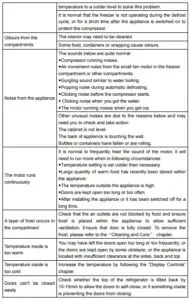
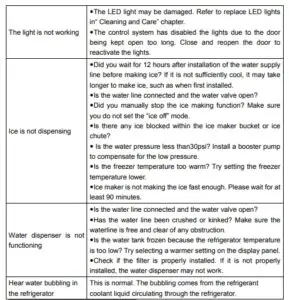
Disposal of the Appliance
It is prohibited to dispose of this appliance as household waste.
Packaging materials
Packaging materials with the recycle symbol are recyclable. Dispose of the packaging into a suitable waste collection container to recycle it.
Before disposal of the appliance
- Pull out the main plug from the main socket.
- Cut off the power cord and discard with the main plug
Warning! Refrigerators contain refrigerant and gases in the insulation. Refrigerant and gases must be disposed of professionally as they may cause eye injuries or ignition.Ensure that tubing of the refrigerant circuit is not damaged prior to proper disposal.
Correct Disposal of this product:This symbol on the product or in its packing indicates that this product may not be treated as household waste. Instead, it should be taken to the appropriate waste collection point for the recycling of electrical and electronic equipment. By ensuring this product is disposed of correctly, you will help prevent potential negative consequences for the environment and human health, which could otherwise be caused by the inappropriate waste handling of this product. For more detailed information about the recycling of this product, please contact your local council, your household waste disposal service, or the shop where you purchased the product.
Hisense, Refrigerator, RB17N6DWE, RB17N6DSE – Hisense, Refrigerator, RB17N6DWE, RB17N6DSE –
[xyz-ips snippet=”download-snippet”]


